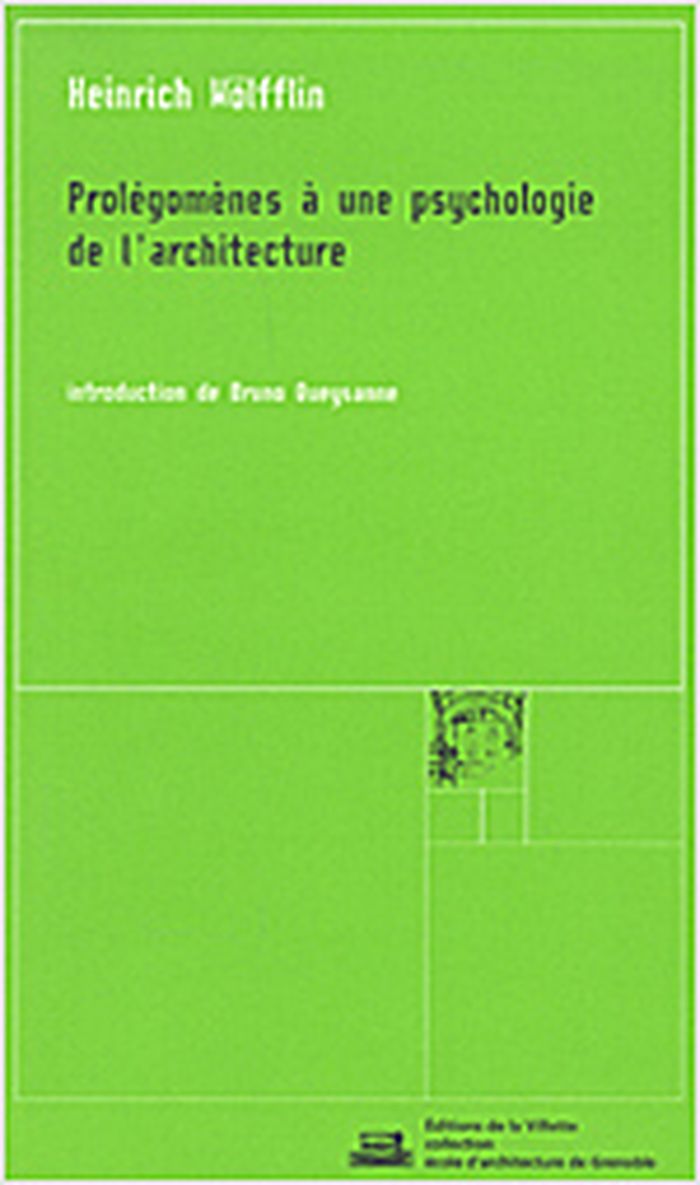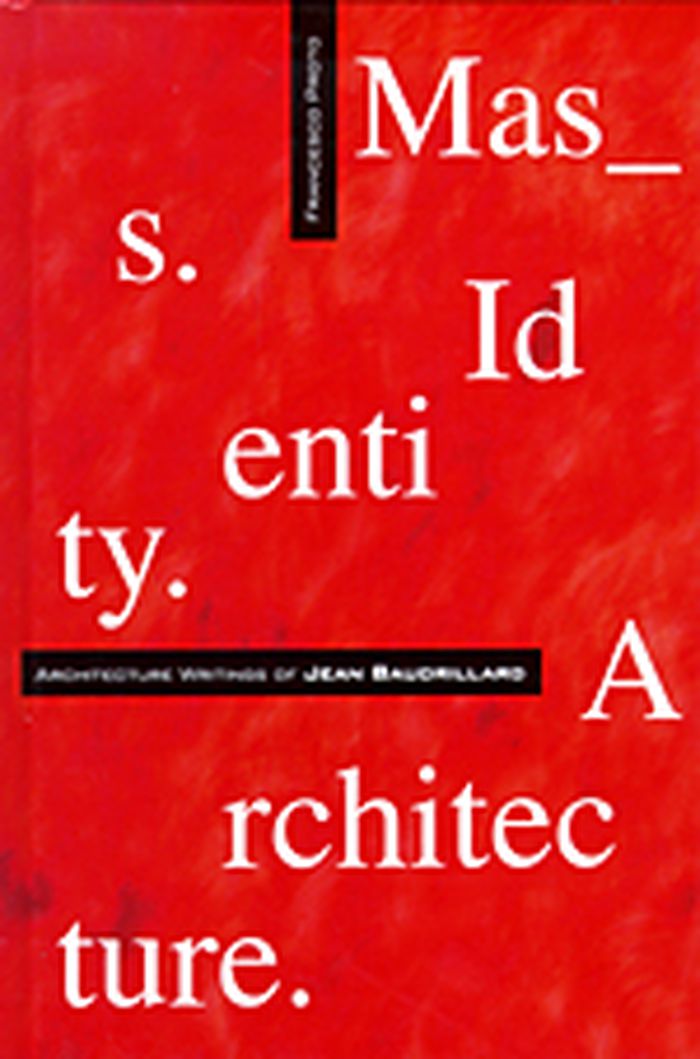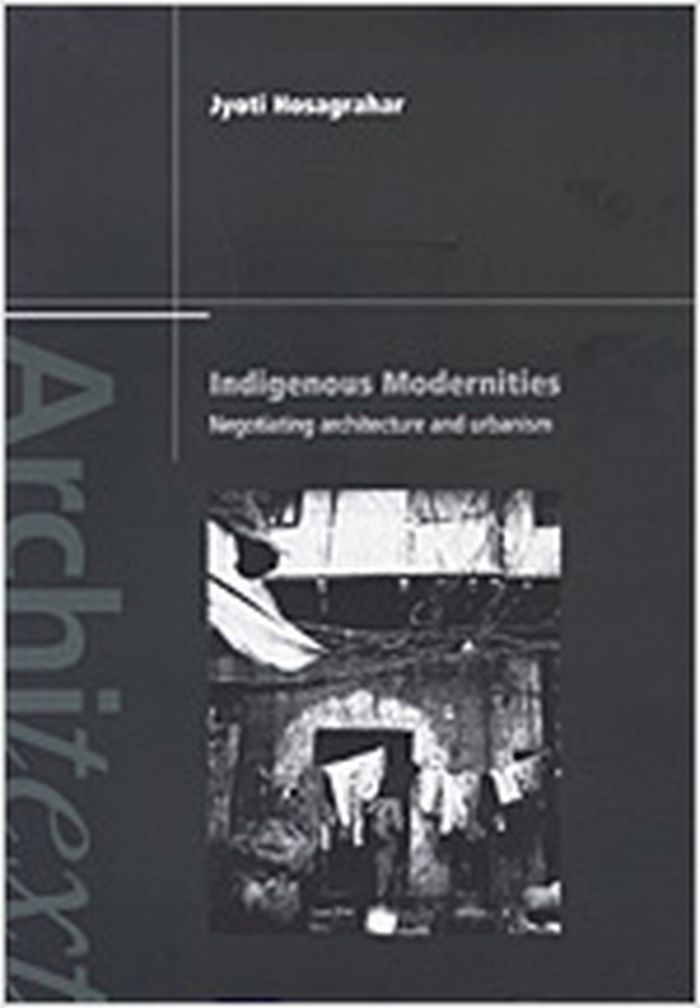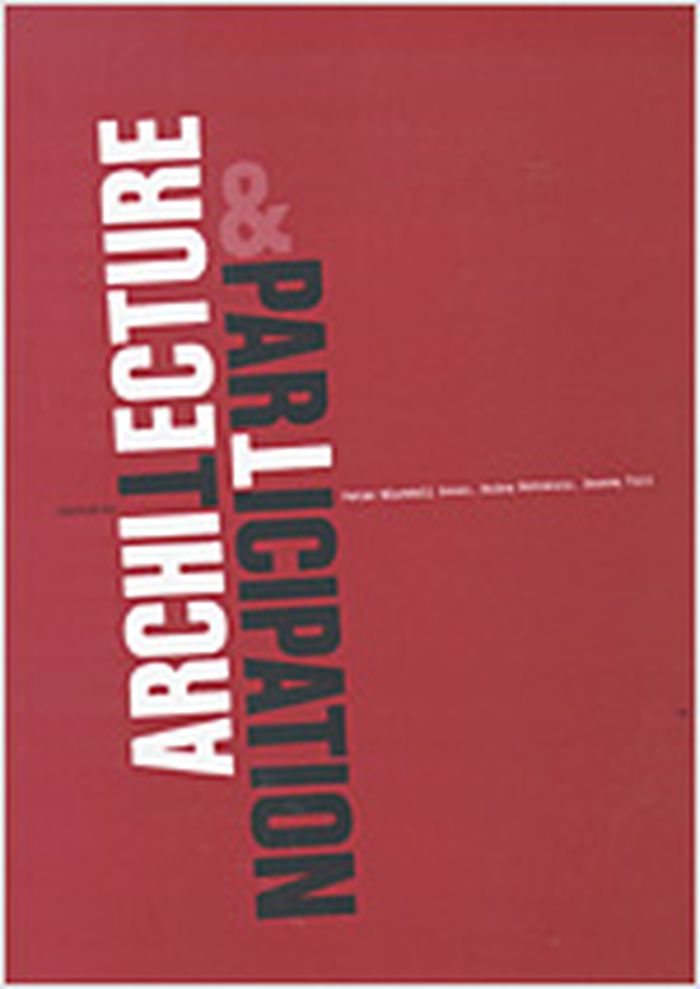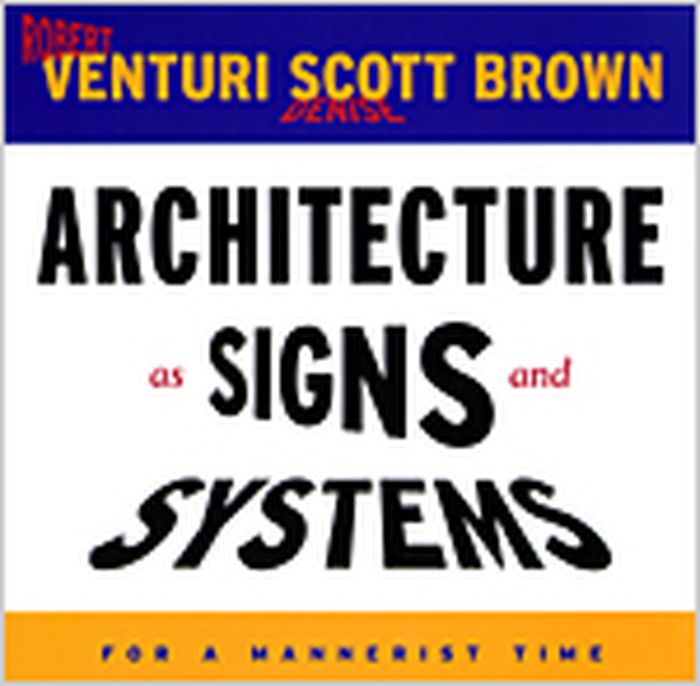$24.95
(available to order)
Summary:
Bruno Queysanne travaille avec Raymond Aron et Pierre Bourdieu à l’issu de ses études à la Sorbonne. Il est professeur d’histoire et de philosophie à l’école d’architecture de Grenoble, après avoir enseigné à l’École des Beaux-Arts, Il a notamment traduit et publié Prolégomènes à une psychologie de l’architecture d’Heinrich Wölfflin.Premier essai de réflexion sur la(...)
Prolégomènes à une psychologie de l'architecture
Actions:
Price:
$24.95
(available to order)
Summary:
Bruno Queysanne travaille avec Raymond Aron et Pierre Bourdieu à l’issu de ses études à la Sorbonne. Il est professeur d’histoire et de philosophie à l’école d’architecture de Grenoble, après avoir enseigné à l’École des Beaux-Arts, Il a notamment traduit et publié Prolégomènes à une psychologie de l’architecture d’Heinrich Wölfflin.Premier essai de réflexion sur la perception que l’on a des formes architecturales, ce texte est l’œuvre d’un tout jeune historien de l’art à qui l’on doit le très célèbre Renaissance et baroque.La psychologie de l’architecture tel que l’entend Wölfflin plonge ses racines dans les pensées de Kant et de Schopenhauer. Ce faisant, elle prend son essor, que l’on pourrait qualifier d’ailleurs de phénoménologique, anticipant à certains égards la pensée de Merleau-Ponty. En outre, il développe une approche synesthésique du monde et de l’espace.
Architectural Theory
books
La visite du monument
$51.95
(available to order)
Summary:
Les monuments portent un message. Que se passe-t-il lorsque des voyageurs découvrent les édifices et les parcourent ? Au moment de la visite, en effet, le message porté par le monument s’actualise et acquiert une signification. Cette dernière change au cours des siècles en fonction des modes de visite que privilégie la société du temps. Dans ce volume consacré aux Actes(...)
Architectural Theory
September 2004, Clermont-Ferrand
La visite du monument
Actions:
Price:
$51.95
(available to order)
Summary:
Les monuments portent un message. Que se passe-t-il lorsque des voyageurs découvrent les édifices et les parcourent ? Au moment de la visite, en effet, le message porté par le monument s’actualise et acquiert une signification. Cette dernière change au cours des siècles en fonction des modes de visite que privilégie la société du temps. Dans ce volume consacré aux Actes d’un colloque international tenu à Clermont-Ferrand, historiens, conservateurs et spécialistes de l’architecture ont exploré les différentes dimensions de la question à partir d’exemples choisis dans un temps long, allant de l’Antiquité grecque à la période la plus contemporaine. Ils ont traité à la fois des recommandations édictant les règles de la «bonne visite » (portées, par exemple, par les guides de voyage) et des pratiques, telles que les Mémoires des contemporains, ou l’observation de l’utilisation d’Internet aujourd’hui, permettent de les reconstituer. Ce point de vue original permet de renouveler la réflexion sur l’usage social du patrimoine.
books
September 2004, Clermont-Ferrand
Architectural Theory
books
Ambiances en débats
$92.95
(available to order)
Summary:
Très présente dans le langage quotidien, la notion d’ambiance a trouvé une forme plus précise dans l’enseignement de l’architecture et du génie civil. Elle connaît aussi aujourd’hui un regain de popularité dans les discours sur la ville. Plutôt que d’apporter une formalisation théorique et définitive de la notion «d’ambiance architecturale et urbaine», Ambiances en débats(...)
Architectural Theory
June 2004,
Ambiances en débats
Actions:
Price:
$92.95
(available to order)
Summary:
Très présente dans le langage quotidien, la notion d’ambiance a trouvé une forme plus précise dans l’enseignement de l’architecture et du génie civil. Elle connaît aussi aujourd’hui un regain de popularité dans les discours sur la ville. Plutôt que d’apporter une formalisation théorique et définitive de la notion «d’ambiance architecturale et urbaine», Ambiances en débats la met à l’épreuve d’une réflexion collective structurée en six approches ouvertes sur un débat. Une position épistémologique claire et récurrente traverse néanmoins le livre. D’un savoir technologique et morcelé des ambiances, tout juste capable d’encadrer le projet architectural par des normes et inapte à aider la création architecturale en elle-même, il faut passer désormais à la compréhension complexe et unifiante de ce qu’est une ambiance concrète. C’est pour explorer ce paradoxe d’une pluralité sue mais vécue ou créée dans la singularité et le circonstanciel qu’Ambiances en débats se situe délibérément au carrefour des disciplines les plus diverses, de la philosophie à l’acoustique physique, de la sociologie à l’urbanisme ou à l’architecture, du domaine spéculatif de la recherche à celui de la conception pratique de l’espace.
books
June 2004,
Architectural Theory
books
$38.95
(available to order)
Summary:
Les architectures molles, sculptées, transparentes, immatérielles prétendent se libérer des contraintes géométriques, comme si la géométrie ne revendiquait que la droite et la forme orthogonale ou le cercle ! Certains architectes s’abandonnent aux « hasards » informatiques et construisent des édifices à la géométrie chahutée par un logiciel. Des urbanistes opposent encore(...)
Géométrie mesure du monde : philosophie, architecture, urbain
Actions:
Price:
$38.95
(available to order)
Summary:
Les architectures molles, sculptées, transparentes, immatérielles prétendent se libérer des contraintes géométriques, comme si la géométrie ne revendiquait que la droite et la forme orthogonale ou le cercle ! Certains architectes s’abandonnent aux « hasards » informatiques et construisent des édifices à la géométrie chahutée par un logiciel. Des urbanistes opposent encore le plan radioconcentrique au plan en damier en ce qui concerne l’expansion des villes et, refusant d’imaginer d’autres morphologies, laissent faire la promotion immobilière, les opportunités foncières et le chacun pour soi. La géométrie, dans notre culture marquée par la philosophie grecque, est constitutive de l’architecture et de l’urbanisme. Elle est mise en débat par le jeu extraordinairement varié des formes et de leurs agencements, aussi bien que par des régulations qui donnent une mesure au monde et suscitent des questionnements quant à ce qui est à la mesure de l’existence. Depuis le simple pas jusqu’aux théories les plus sophistiquées, la géométrie – qui n’a jamais cessé de se complexifier depuis Pythagore ou Euclide – se rappelle à nous. C’est ce rappel qu’il nous faut entendre, comme une invitation à penser aussi bien notre corps que le paysage, aussi bien la maison que la ville et la cité. Cet ouvrage collectif veut questionner géométriquement et philosophiquement l’urbain contemporain et les architectures qu’il provoque. En d’autres termes, il espère saisir à partir de la confrontation entre mathématiciens, géomètres, historiens, architectes, urbanistes, paysagistes, philosophes, l’expérience existentielle de l’espace-temps des lieux.
books
December 2004, Paris
Architectural Theory
books
$32.95
(available to order)
Summary:
This ambitious collection treating the Italian Fascists’ appropriation of the past for political purposes focuses on the role of the visual in the aim of fusing the past and the modern world in Mussolini’s Italy. With contributions by art historians and classicists, literary and intellectual historians, "Donatello among the Blackshirts" demonstrates that the Fascist(...)
Architectural Theory
September 2004, Ithaca
Donatello and the Blackshirts : history and modernity in the visual culture of fascist Italy
Actions:
Price:
$32.95
(available to order)
Summary:
This ambitious collection treating the Italian Fascists’ appropriation of the past for political purposes focuses on the role of the visual in the aim of fusing the past and the modern world in Mussolini’s Italy. With contributions by art historians and classicists, literary and intellectual historians, "Donatello among the Blackshirts" demonstrates that the Fascist regime appropriated not only Italy’s ancient Roman past but also the medieval, Renaissance, and even baroque eras, as well as its own recent history, in constructing a new myth of the nation. Every aspect of visual culture—from monumental architecture, sculpture, painting, and gardens to exhibitions, spectacles, films, medals, household items, and stamps—helped to link the past with modernity. As a result, Italy’s artistic traditions became familiar to all social classes throughout the peninsula. While this richly illustrated book concerns Fascist Italy, at the same time it also shows how Italy’s premodern artistic traditions have been passed down to the present through the filter of the Fascist era.
books
September 2004, Ithaca
Architectural Theory
books
Memory and architecture
$64.95
(available to order)
Summary:
Using the analytical perspectives of architecture, comparative literatue, and cultural studies, "Memory and architecture" examines the role of memory in the creation of our built environment.
Memory and architecture
Actions:
Price:
$64.95
(available to order)
Summary:
Using the analytical perspectives of architecture, comparative literatue, and cultural studies, "Memory and architecture" examines the role of memory in the creation of our built environment.
books
December 2004, Albuquerque
Architectural Theory
$97.99
(available to order)
Summary:
The aim of this book is thus to provide new methodologies and to suggest new meanings for the comprehension and development of contemporary architecture. In Baudrillard’s terms, architecture could be seen as the supreme medium of contemporary visual culture, especially in its potential to influence the individual’s perception of reality as a component of the mass-media(...)
Mass, identity, architecture : architectural writings of Jean Baudrillard
Actions:
Price:
$97.99
(available to order)
Summary:
The aim of this book is thus to provide new methodologies and to suggest new meanings for the comprehension and development of contemporary architecture. In Baudrillard’s terms, architecture could be seen as the supreme medium of contemporary visual culture, especially in its potential to influence the individual’s perception of reality as a component of the mass-media system. This kind of cultural analysis of the built environment and its effect on everyday life is still a relatively new phenomenon – both in the fields of critical theory and even more so in mainstream architectural criticism. This book, which forms a significant resource on the work of an immensely important writer, should appeal to a wide range of readers. Through highly evocative writing, it provides a theoretical, illuminating pathway for everyone who, either directly or indirectly, is involved or interested in architecture, urbanism and related subjects.
Architectural Theory
$58.50
(available in store)
Summary:
This book examines the ways in which a historic, and so-called 'traditional' city quietly mutated into one that was modern in its own terms not only in form but also in its use and meaning. Through a study of Delhi, the author challenges some prevalent dichotomies and myths in architecture and urbanism and identifies an interpretation of modernism that expands upon(...)
April 2005, London
Indigenous modernities : negotiating architecture and urbanism
Actions:
Price:
$58.50
(available in store)
Summary:
This book examines the ways in which a historic, and so-called 'traditional' city quietly mutated into one that was modern in its own terms not only in form but also in its use and meaning. Through a study of Delhi, the author challenges some prevalent dichotomies and myths in architecture and urbanism and identifies an interpretation of modernism that expands upon conventional understandings of it. Conventional discourse in the West defines modern as the antithesis of that which is 'not-modern' or is 'traditional.' Many scholars have debated the significance of the words and most agree that the very word 'tradition' was a modernist creation that variously implied backwardness, threatened by change, resistance to innovation. The first part of this book reflects on the transformations and discontinuities in built form and spatial culture and calls into question accepted notions of the static nature of what is normally referred to as 'traditional' and 'non-Western' architecture. The second part is a critical discussion of Delhi in the nineteenth and early twentieth centuries. It expands upon conventional understandings of modernity in a way that wrenches free the city's architecture and the society from the objectified realm of the exotic while also acknowledging cultural conditions of modernity and modern architecture outside the West. Stepping outside Western canons, this project looks at late nineteenth and early twentieth century architecture to include them in a conversation on architecture that has typically focused on Western Europe and North America. Finally, the author seeks out the 'indigenous modernities': the irregular, the uneven, and the unexpected in what uncritical observers might label a perfectly coherent 'traditional' built environment; or in the influence of local society and institutions on forms that appear modern by conventional standards in the West.
$102.95
(available to order)
Summary:
This book questions whether a participative approach to architecture may lead to new spatial conditions as well as to new types of architectural practices.
Architectural Theory
April 2005, London
Architecture and participation
Actions:
Price:
$102.95
(available to order)
Summary:
This book questions whether a participative approach to architecture may lead to new spatial conditions as well as to new types of architectural practices.
Architectural Theory
$45.95
(available to order)
Summary:
Robert Venturi exploded onto the architectural scene in 1966 with a radical call to arms in "Complexity and Contradiction". Further accolades and outrage ensued in 1972 when Venturi and Denise Scott Brown (along with Steven Izenour) analyzed the Las Vegas strip as an archetype in "Learning from Las Vegas". Now, for the first time, these two observer-designer-theorists(...)
Architectural Theory
October 2004, Cambridge, Mass.
Architecture as signs and systems for a mannerist time
Actions:
Price:
$45.95
(available to order)
Summary:
Robert Venturi exploded onto the architectural scene in 1966 with a radical call to arms in "Complexity and Contradiction". Further accolades and outrage ensued in 1972 when Venturi and Denise Scott Brown (along with Steven Izenour) analyzed the Las Vegas strip as an archetype in "Learning from Las Vegas". Now, for the first time, these two observer-designer-theorists turn their iconoclastic vision onto their own remarkable partnership and the rule-breaking architecture it has informed. The views of Venturi and Scott Brown have influenced architects worldwide for nearly half a century. Pluralism and multiculturalism; symbolism and iconography; popular culture and the everyday landscape; generic building and electronic communication are among the many ideas they have championed. Here, they present both a fascinating retrospective of their life work and a definitive statement of its theoretical underpinnings. Accessible, informative, and beautifully illustrated, Architecture as Signs and Systems is a must for students of architecture and urban planning, as well as anyone intrigued by these seminal cultural figures. Venturi and Scott Brown have devoted their professional lives to broadening our view of the built world and enlarging the purview of practitioners within it. By looking backward over their own life work, they discover signs and systems that point forward, toward a humane Mannerist architecture for a complex, multicultural society.
Architectural Theory
